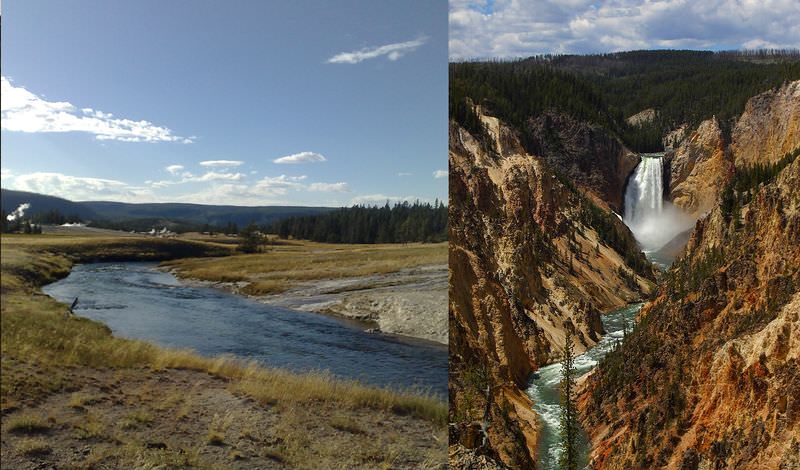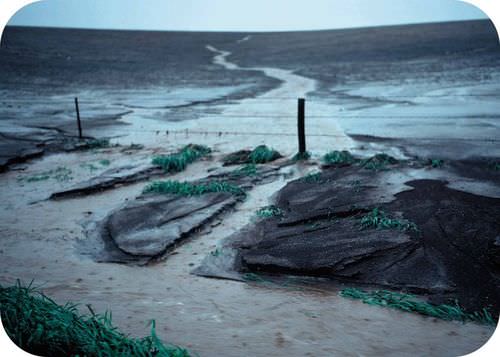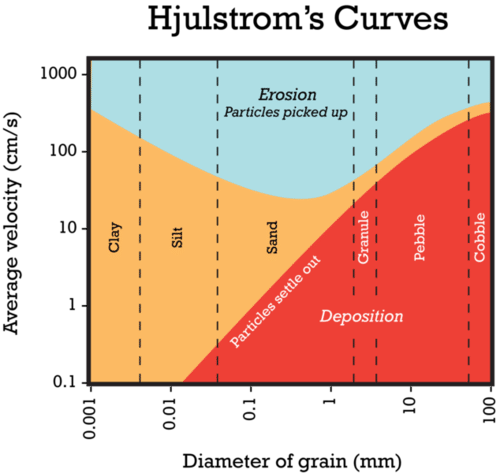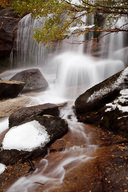14.1溪流侵蚀
章节大纲
-
What's different about these landscapes?
::这些风景有什么不同?Both of these rivers run through Yellowstone National Park. The Firehole River is a tributary of the Madison. In this photo, it's flowing over flat ground. The Yellowstone River on the right is cascading over Yellowstone Falls. Which river is doing more erosion ? In what direction is the stream eroding?
::这两条河流都穿过黄石公园。 火洞河是麦迪逊河的支流。 在这张照片中, 它在平坦的地面上流动。 右边的黄石河在黄石瀑布上层层层层。 哪一条河在进行更多的侵蚀? 流向哪个方向的侵蚀?Erosion by Surface Water
::地表水侵蚀Water that flows over Earth’s surface includes runoff , streams, and rivers. All these types of flowing water can cause erosion and deposition.
::流过地球表面的水包括径流、溪流和河流。 所有这些类型的流水都会导致侵蚀和沉降。Erosion by Runoff
::径流侵蚀When a lot of rain falls in a short period of time, much of the water is unable to soak into the ground. Instead, it runs over the land. Gravity causes the water to flow from higher to lower ground. As the runoff flows, it may pick up loose bits of soil and sand.
::当大雨在短短的时间内降下时,许多水无法渗入地面。相反,它会穿过土地。重水导致水从高处流到低处。随着径流的流出,它可能会吸收松散的土壤和沙子。Runoff causes more erosion if the land is bare. Plants help hold the soil in place. The runoff water pictured below ( Figure ) is brown because it eroded soil from a bare, sloping field. Can you find evidence of erosion by runoff where you live? What should you look for?
::如果土地是空的, 径流会造成更多的侵蚀。 植物有助于将土壤固定在原地。 下面的径流水( 图)是棕色的, 因为它侵蚀了裸露的田地上的土壤。 你能找到径流侵蚀的证据吗 ? 您要寻找什么 ?Runoff has eroded small channels through this bare field. Much of the material eroded by runoff is carried into bodies of water, such as streams, rivers, ponds , lakes , or oceans. Runoff is an important cause of erosion. That’s because it occurs over so much of Earth’s surface.
::径流侵蚀的大部分物质被带入水体,如溪流、河流、池塘、湖泊或海洋。 径流是侵蚀的重要原因。 这是因为径流发生在地球表面的很多地方。Erosion by Streams
::流流侵蚀Streams erode sediment from their banks. They pick up and transport sediments.
::溪流侵蚀来自其银行的沉积物,它们收集并运输沉积物。A stream in the desert rushes past its banks. The power of the water erodes the cliff face. As a stream erodes its banks, it creates a V-shaped valley ( Figure ). This contrasts with the U-shaped valleys created by .
::当溪流侵蚀其河岸时,它创造了一个V形山谷(图 )。 这与由 U 形山谷所创造的 U 形山谷形成反差 。Erosion and Water Speed
::侵蚀和水速Erosion by a stream depends on the velocity of the water. Fast water erodes more material than slow water. Eventually, the water deposits the materials. As water slows, larger particles are deposited first. As the water slows even more, smaller particles are deposited. The graph pictured below ( Figure ) shows how water velocity and particle size influence erosion and deposition.
::溪流侵蚀取决于水的速度。 快速水侵蚀的物质多于慢水。 最终, 水会沉积物质。 随着水慢, 较大的粒子首先沉积。 随着水慢, 较小的粒子沉积。 下图( 图 ) 显示了水速和粒子大小如何影响侵蚀和沉积。Flowing water erodes or deposits particles depending on how fast the water is moving. It also depends on how big the particles are. Erosion in the Mountains
::山区的侵蚀Streams often start in mountains , where the land is very steep ( Figure ). A mountain stream flows very quickly because of the steep slope. This causes a lot of erosion and very little deposition. The rapidly falling water digs down into the stream bed and makes it deeper. It carves a narrow, V-shaped channel.
::溪流往往从山中开始,那里的土地非常陡峭(图 ) 。 山流由于陡峭的斜坡而迅速流动。 这造成了大量的侵蚀和极少的沉降。 迅速下降的水从河床中钻入河床,使其更深。 它雕刻了一个狭窄的V形通道。This mountain stream is in Whitney Portal in the Sierra Nevada of California. The slope is so steep that water cascades down in a waterfall. How Waterfalls Form
::瀑布如何形成Mountain streams may erode waterfalls. A waterfall forms where a stream flows from an area of harder to softer ( Figure ). The water erodes the softer rock faster than the harder rock. This causes the stream bed to drop down, like a step. This creates a waterfall. As erosion continues, the waterfall gradually moves upstream.
::山流可能会侵蚀瀑布。 瀑布的形式是溪流从较难的地区流向较软的地区( 图 ) 。 水侵蚀较软的岩石的速度比较硬的岩石更快。 这导致河床像一步一样下降。 这造成了瀑布。 随着侵蚀的继续,瀑布会逐渐向上游移动。How a waterfall forms and moves. Why does a waterfall keep moving upstream? Erosion by Slow-Flowing Rivers
::慢流河侵蚀Streams eventually run onto flatter ground. Rivers flowing over gentle slopes erode the sides of their channels more than the bottom. Large curves, called meanders , form because of erosion and deposition by the moving water. The curves are called meanders because they slowly “wander,” or meander , over the land. Below, you can see how this happens ( Figure ).
::流最终会跑到平坦的地面上。 流过温和的斜坡的河流比底部更侵蚀了河道的两侧。 大曲线 — — 被称为“下坡 ” — —因为水的侵蚀和沉降而形成。 这些曲线被称为“下坡 ” , 因为它们在陆地上缓慢地“ 下坡 ” , 或 冲浪。 下面,你可以看到这种情况是如何发生的(图 ) 。Meanders form because water erodes the outside of curves and deposits eroded material on the inside. Over time, the curves shift position. As meanders erode from side to side, they create a floodplain . This is a broad, flat area on both sides of a river. Eventually, a meander may become cut off from the rest of the river. This forms an oxbow lake ( Figure ).
::当沙丘从侧向侧侵蚀时,它们会形成一个洪泛地带。这是河两岸宽阔、平坦的地区。最终,草地可能会与河的其余部分隔绝。这形成一个牛弓湖(图 ) 。An oxbow lake forms in the Mackenzie River Delta, Canada. Science Friday: The Lollipop Hypothesis
::科学星期五:棒棒糖假说Ever wondered how many licks it takes to reach the center of a lollipop? Mathematicians at NYU’s applied mathematics lab have designed experiments to determine this. Find out in this video by Science Friday.
::纽约大学应用数学实验室的数学家们设计了实验来确定这一点。 在科学周五的这段视频中,我们可以看到这一点。Summary
::摘要- Faster water carries more and larger sediment.
::更快的水携带越来越多的沉积物。
- Streams erode their banks to create V-shaped valleys.
::溪流侵蚀他们的银行 以创造V形山谷
- A river on flat ground meanders. When a meander is cut off, it may become an oxbow lake.
::一条河在平坦的地面下沉积处,当一个米德被切断时,它可能变成一个牛弓湖。
- A floodplain is where the extra water goes when the river is in flood.
::河水淹没时,洪泛地是额外水流流向的地方。
Review
::回顾- Where along a meander does a river erode its banks? Where does it deposit sediment? Why?
::河水侵蚀河岸,河水沉积到哪里?为什么?河水沉积到哪里?
- How does a waterfall form?
::瀑布是怎样形成的?
- How does stream erosion in the high mountains differ from that on flatter ground?
::高山的溪流侵蚀与平坦地的河流侵蚀有何不同?
- How does erosion by runoff differ from stream erosion?
::径流侵蚀与溪流侵蚀有何不同?
- Faster water carries more and larger sediment.







